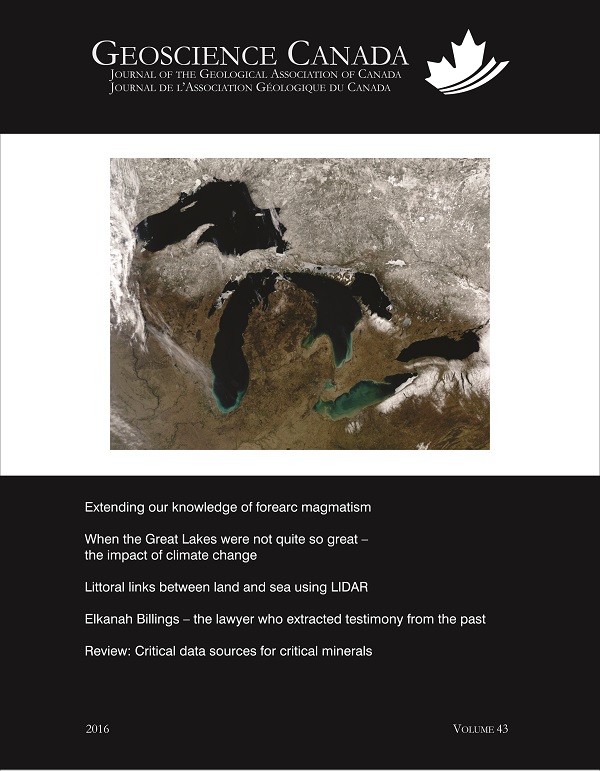Remote Predictive Mapping 7. The Use of Topographic–Bathymetric Lidar to Enhance Geological Structural Mapping in Maritime Canada
Published 2016-09-30
How to Cite
Abstract
An airborne topo-bathymetric lidar survey was conducted at Cape John, on the north shore of Nova Scotia, Canada, using the shallow water Leica AHAB Chiroptera II sensor. The survey revealed new bedrock features that were not discovered using previous mapping methods. A thick blanket of glacial till covers the bedrock on land, and outcrops are exposed only along the coastal cliffs and offshore reefs. The seamless landseabed digital elevation model produced from the lidar survey revealed significant bedrock outcrop offshore where ocean currents have removed the glacial till, a significant finding that was hitherto hidden under the sea surface. Several reefs were identified offshore as well as a major fold structure where block faulting occurs along the limbs of the fold. The extension of the Malagash Mine Fault located ~10 km west of Cape John is proposed to explain the local folding and faulting visible in the submerged outcrops. The extension of this fault is partially visible on land, where it is obscured by glacial till, and its presence is supported by the orientation of submerged bedding and lineaments on both the south and north sides of Cape John. This paper demonstrates how near-shore high-resolution topography from bathymetric lidar can be used to enhance and refine geological mapping.
RÉSUMÉ
Un levé lidar topo-bathymétrique été réalisé à Cape John, sur la rive nord de la Nouvelle-Écosse, Canada, en utilisant un capteur Leci AHAB Chiroptera II. Ce levé a permis de repérer des affleurements que les méthodes de cartographie plus anciennes n’avaient pu détecter. Une épaisse couche de till glaciaire recouvre la roche en place sur le continent, et la roche affleure seulement le long des falaises côtières et des récifs côtiers. Le modèle numérique de dénivelé en continu terres et fonds marins obtenu par le levé lidar a révélé l’existence d’affleurement rocheux considérables au large des côtes, là où les courants océaniques ont emporté le till glaciaire, une découverte importante demeurée cachée sous la surface de la mer jusqu’alors. Plusieurs récifs ont été identifiés au large des côtes, ainsi qu’une structure de pli majeure, à l’endroit où se produit un morcellement en blocs le long des flancs du pli. Une extension de la faille de la mine Malagash situé ~ 10 km à l’ouest de Cape John est proposé pour expliquer les plis et les failles locaux visibles dans les affleurements submergés. L’extension de cette faille est partiellement visible sur la terre, voilée par le till, et sa présence est étayée par l’orientation de la stratification et des linéaments submergés tant du côté sud que nord de Cape John. Cet article montre comment la topographie haute résolution du lidar bathymétrique peut être utilisée pour améliorer et affiner la cartographie géologique.
